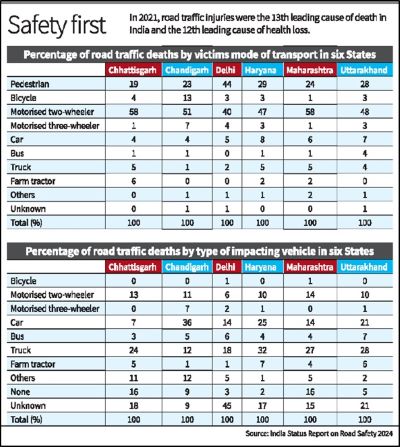Context-
The "India Status Report on Road Safety 2024," prepared by the TRIP Centre at IIT Delhi, provides a comprehensive analysis of India's road safety landscape. It underscores India's slow progress towards meeting international goals of reducing road accident fatalities and highlights the intricate connection between road construction, mobility, and the necessity for a differentiated approach to mitigate road accidents.
India's Progress on International Road Safety Goals
● The report analyzes road safety in India using data sourced from First Information Reports (FIRs) from six States and audits of State compliance with Supreme Court directives on road safety governance. It highlights the uneven progress in reducing road traffic fatalities across the country. Vulnerable groups such as motorcyclists are disproportionately affected, and the rate of fatal crashes involving trucks remains high. Despite advancements in other sectors, road traffic injuries continue to be a major public health issue in India, with little reduction in fatalities.
● Most Indian States are unlikely to meet the United Nations Decade of Action for Road Safety goal, which aims to halve traffic deaths by 2030. In 2021, road traffic injuries were the 13th leading cause of death in India and the 12th leading cause of health loss, measured in Disability-Adjusted Life Years (DALYs). In six States—Haryana, Jammu and Kashmir and Ladakh, Punjab, Rajasthan, Uttarakhand, and Uttar Pradesh—road traffic injuries ranked among the top 10 causes of health loss.
Disparities in Road Safety Across States
● Road safety varies significantly across India, with per capita death rates differing more than threefold between States. Tamil Nadu, Telangana, and Chhattisgarh recorded the highest death rates, at 21.9, 19.2, and 17.6 per 100,000 people, respectively. Conversely, West Bengal and Bihar had the lowest rates, at 5.9 per 100,000 in 2021. Six States—Uttar Pradesh, Maharashtra, Madhya Pradesh, Karnataka, Rajasthan, and Tamil Nadu—account for nearly half of all traffic fatalities in India.
● The report identifies pedestrians, cyclists, and motorised two-wheeler riders as the most common victims of road accidents. Trucks are the leading impacting vehicles in fatal crashes. Alarmingly, helmet usage among motorised two-wheeler riders is below 50% in all but seven States, despite helmets being a simple and effective safety measure to reduce fatalities and serious injuries.

● Only eight States have audited more than half of their National Highway lengths, and even fewer have done so for their State Highways. Basic traffic safety measures, including traffic calming, markings, and signage, remain inadequate in most States. Helmet usage in rural areas is particularly low, and trauma care facilities are insufficient to meet the needs of accident victims. The report emphasizes the need for tailored strategies to address the unique road safety challenges faced by different States.
The Need for a National Crash Surveillance System
● India's national road safety data systems are currently inadequate for guiding effective public policy. The absence of a national crash-level database is a significant gap, as road safety statistics at both State and national levels are derived from individual police station records that are aggregated at district, State, and national levels. This aggregation process results in data tables that allow only basic analyses, limiting the ability to conduct effective interventions or evaluate the success of existing programs.
● Comparisons with other datasets, such as the Global Burden of Disease (GBD) study and the Sample Registration System (SRS), indicate discrepancies in the data, particularly in critical areas such as the victim’s mode of transport. This information is vital for effective road safety management. Due to the lack of a crash surveillance system, the report had to rely on FIRs from six States and audits of State road safety governance.
India's Global Standing in Road Safety
● The report presents a stark comparison between India and developed countries like Sweden and other Scandinavian nations, which have excelled in road safety governance. In 1990, an Indian was 40% more likely to die in a road accident than someone in these countries. By 2021, this figure had soared to 600%, reflecting a sharp increase in road fatalities in India compared to these nations. This troubling trend raises questions about whether better-equipped vehicles with advanced safety features alone are sufficient solutions, given that two-wheeler riders, cyclists, and motorcyclists constitute the majority of road fatalities in India.
Challenges in Road Safety Management
The report underscores several critical challenges in managing road safety in India:
1. Data Limitations: The absence of a national crash-level database hampers the ability to accurately track and analyze road traffic incidents. Current data collection methods are fragmented and often contain inaccuracies, particularly concerning critical variables such as the mode of transport of victims.
2. Inadequate Safety Measures: Despite the known effectiveness of safety measures like helmets, their usage remains low, particularly in rural areas. Basic traffic safety infrastructure, including proper signage, road markings, and traffic calming measures, is lacking across most States.
3. High-Risk Groups: Motorcyclists, cyclists, and pedestrians are identified as the most vulnerable groups in road traffic incidents. The high rate of fatal crashes involving trucks further exacerbates the risk for these road users.
4. Insufficient Trauma Care: The report highlights the inadequacy of trauma care facilities in India, which are crucial for saving lives and reducing the severity of injuries following road accidents.
5. Regional Disparities: The significant variation in road safety performance across States points to the need for region-specific interventions. Some States lag far behind in implementing even the most basic safety measures.
Recommendations and Way Forward
To address the identified challenges, the report calls for urgent action from both Central and State governments to scale up road safety interventions. Key recommendations include:
1. Establishing a National Database for Fatal Crashes: A comprehensive national database would enable detailed analysis of road traffic incidents and help identify specific risk factors and the effectiveness of various interventions. Public access to this database could enhance transparency and foster better understanding among stakeholders.
2. Enhancing Safety Measures: The report stresses the need for a concerted effort to increase helmet usage, particularly among motorised two-wheeler riders. Expanding the scope of road audits and implementing basic safety measures, such as traffic calming, proper signage, and road markings, are also critical steps.
3. Improving Trauma Care: Strengthening trauma care facilities across the country is essential to reduce fatalities and improve outcomes for accident victims. This includes increasing the number of trauma care centers and ensuring they are equipped with the necessary resources.
4. Tailored Regional Strategies: Given the significant disparities in road safety performance across States, the report advocates for tailored strategies that address the specific needs and challenges of different regions. This approach would involve localized planning and targeted interventions.
5. Public Awareness and Education: Increasing public awareness of road safety and promoting responsible behavior among road users are vital components of any comprehensive road safety strategy. Educational campaigns, stricter enforcement of traffic laws, and community engagement are all important elements in fostering a culture of safety.
Conclusion
The "India Status Report on Road Safety 2024" paints a sobering picture of the current state of road safety in India. While there have been some improvements, much work remains to be done to meet international targets and protect vulnerable road users. By establishing a national crash surveillance system, enhancing safety measures, and implementing tailored strategies, India can make significant strides towards reducing road traffic fatalities and achieving its road safety goals. The report serves as a critical call to action for policymakers, stakeholders, and the public to prioritize road safety and work collaboratively to create safer roads for all.
|
Probable% Questions for UPSC Mains Exam- 1. What are the key challenges identified in the "India Status Report on Road Safety 2024" that hinder effective road safety management in India, and what steps does the report recommend to address these challenges? (10 Marks, 150 Words) 2. How does the absence of a national crash surveillance system impact road safety policy-making in India, and what role does such a system play in improving road traffic safety according to the report? (15 Marks, 250 Words) |
Source - The Hindu







